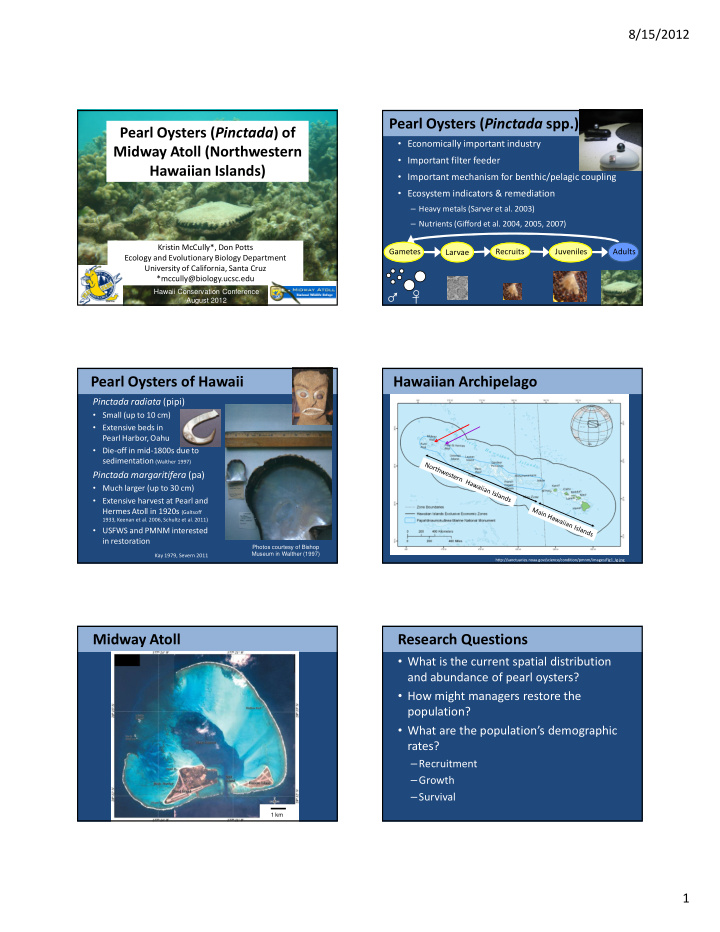



8/15/2012 Pearl Oysters ( Pinctada spp.) Pearl Oysters ( Pinctada ) of • Economically important industry Midway Atoll (Northwestern • Important filter feeder Hawaiian Islands) • Important mechanism for benthic/pelagic coupling • Ecosystem indicators & remediation – Heavy metals (Sarver et al. 2003) – Nutrients (Gifford et al. 2004, 2005, 2007) Kristin McCully*, Don Potts Gametes Recruits Juveniles Adults Larvae Ecology and Evolutionary Biology Department University of California, Santa Cruz *mccully@biology.ucsc.edu Hawaii Conservation Conference August 2012 Pearl Oysters of Hawaii Hawaiian Archipelago Pinctada radiata (pipi) • Small (up to 10 cm) • Extensive beds in Pearl Harbor, Oahu • Die-off in mid-1800s due to sedimentation (Walther 1997) Pinctada margaritifera (pa) • Much larger (up to 30 cm) • Extensive harvest at Pearl and Hermes Atoll in 1920s (Galtsoff 1933, Keenan et al. 2006, Schultz et al. 2011) • USFWS and PMNM interested in restoration Photos courtesy of Bishop Museum in Walther (1997) Kay 1979, Severn 2011 http://sanctuaries.noaa.gov/science/condition/pmnm/images/fig1_lg.jpg Midway Atoll Research Questions • What is the current spatial distribution and abundance of pearl oysters? • How might managers restore the population? • What are the population’s demographic rates? – Recruitment – Growth – Survival 1 km 1
8/15/2012 Distribution: Habitats Distribution: Methods Legend 2009 2011 Habitat Backreef Legend Forereef N Patch reef Forereef Sand Backreef NW Patch reef E Deep Sand n = 108 surveys Based on: NOAA. SE SW 2003. Draft atlas of the shallow-water benthic habitats of the NWHI. S Distribution: Results Restoration? 500 m Phylogeny ML/Bayesian PP Conclusions P. fucata P.f. martensi (3) 0.05 P. fucata (3) • Nuclear marker ITS1 • Pearl oysters are important and efficient filter- substitutions/site P. imbricata (Yu & Chu 2006 ) feeders P. martensi ITS1 18S 5.8S • P. margaritifera is very rare at Midway, but is • Midway samples P. maculata (3) most common on patch reefs in central lagoon 66/98 18 Midway – Definitely not P. • Most recruits are likely P. maculata , a species samples 85/73 margaritifera not previously recorded in Hawaii – Likely P. maculata P. albina (2) • Currently sequencing • Potentially very difficult to restore P. P. chemnitzi (2) mitochondrial P. nigra margaritifera cytochrome oxidase I ( cox1 ) marker • More studies of pearl oyster biology P. margaritifera (4) (Cunha et al. 2010) 99/100 P. maxima needed at Pearl & Hermes Atoll Pteria penguin 2
8/15/2012 Thank you! Pearl Oysters ( Pinctada ) of Midway Atoll (Northwestern Hawaiian Islands) • Wendy Cover • John Klavitter (USFWS) • Anne Warner • Matt Brown (USFWS) • Helen O’Brien • Pete Leary (USFWS) • Rachel Fabian • Sue Schulmeister (USFWS) • Beth Bastiaans • Kate Schoenrock • Norah Saarman • Jamie Barlow • Maria Haws (UH Hilo) • Jessica Lee • Tim Tinker • Danica Zupic • Laurel Fox • Mitsubishi volunteers (2007-2011) NSF GK-12 Kristin McCully*, Don Potts • Pete Raimondi Ecology and Evolutionary Biology Department • Jack Horner (WHS) University of California, Santa Cruz *mccully@biology.ucsc.edu 3
Recommend
More recommend